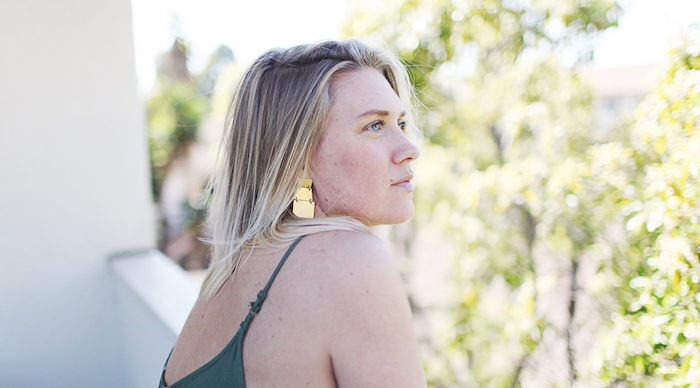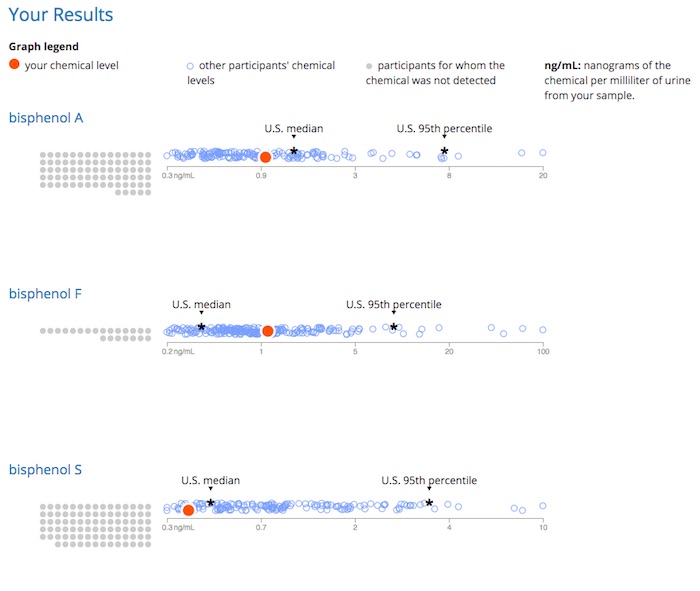I have to admit, this blog post is a little hard to write. I’ve been working on environmental health issues since 2006 and so as you might expect, I’ve been making good choices about which products I use, avoiding known toxic chemicals where possible. So when I signed up for Silent Spring Institute’s biomonitoring study, I thought I was going to do VERY well. A+ with a little extra credit, right? I was surprised by the mixed results.
I have also been in this field long enough to know that I shouldn’t be surprised by my results. Consumer choices are incredibly powerful in reducing our exposure to environmental chemicals, but we also can’t entirely shop our way out of this problem. Which is part of the fuel that has driven me to advocate for more health protective laws over the years; we can’t simply just avoid chemicals because we don’t like them. Many are pervasive and exposure is ubiquitous.
So what did my results show and what do they mean? The answer should energize you…read on.

About the Study
The Silent Spring Institute (a well respected science research organization) tested people for 14 of the most common hormone disrupting chemicals commonly found in household products. Participants like myself had to collect urine samples and then we patiently waited for our results.
According to the Silent Spring Institute, they found 2 to 12 chemicals in each participant, most people had at least 9 chemicals, everyone had a detectable level of the preservative methyl paraben (including me!) and no one had a detectable level of the antimicrobial triclocarban.
My Results
1 – Triclosan/Triclocarbon (found in anti-bacterial soaps)
>>> Good news! Non-detect
I did not have any triclosan or triclocarban detected in my body, chemicals used in “anti-bacterial/microbial” soaps, detergents and toothpaste. (Note: “non-detect” is a term used by scientist to note the absence of chemicals. Scientists don’t like to say “zero” since it’s virtually impossible to prove.)
What this means:
My efforts to purchase and avoid soaps, toothpaste and other products with anti-microbial agents is working! You can read more about how chemicals like triclosan are both harmful to human health and the environment and are simultaneously NOT effective at killing microbes. No wonder the FDA moved to ban this class of chemicals from soap.
2 – Bisphenols (found in canned food, hard plastics, epoxy resins)
>>> Disappointing news: BPF – above U.S. median levels, BPA/BPS – slightly below U.S. median
Here is a chart showing my exposure to BPA, BPS and BPF. As someone who has campaigned on BPA and it’s toxic substitutes for years, this one particularly hurts.

Hypothesis:
After talking to the team at the Silent Spring Institute, I have two main theories for my exposure to bisphenols, specifically BPF. I do not drink or eat from plastic containers and I don’t cook many foods at home with canned food. The theory is a salad bar that I eat lunch at several times a week. In true salad bar fashion, I am drawn to the “fun” food items that I don’t eat at home including kidney beans (canned), artichoke hearts (canned/jar), olives (canned), chickpeas (canned), and so on.
This salad bar experience is meant to give me a healthy meal, which it is, but I’ve been loading up on canned food items to spruce up my salad! I have since started to focus on loading up on the fresh veggies rather than the canned “accent” foods, which I trust will drop the levels.
Finally, and perhaps most important. As BPA started to develop a bad reputation, companies started to use “chemical cousins” BPS and BPF. The structure of these chemicals is similar, and the health threat of hormone disruption equal. As a result, the use of BPS and BPF has skyrocketed in recent years and exposures can come through small interactions in our lives like handling receipts and canned food. This is why laws that address classes of chemicals is very important.
3 – Chlorinated phenols (found in mothballs, toilet deodorizer, herbicides)
>>> Good news: Below U.S. median
While it’s frustrating that chlorinated phenols were detected in my body, I’m happy to see they are below the U.S. median levels. This is likely due to the safer cleaning products I use, I don’t have mothballs in my home, and I don’t use herbicides. Even though I don’t use herbicides in my home, we do leave our windows open all year round which is likely part of my day to day low level exposure.
4 – Flame retardant chemicals (used in furniture, textiles & nail polish)
>>> Non-detect: But room for improvement
I had no present levels of a certain flame retardant used in furniture in my body, which shows that buying flame-retardant free furniture WORKS! I did have some levels (although less than U.S. median) of a chemical called diphenyl phosphate (DPHP), which can form from TPHP, an ingredient used in some conventional nail polishes. For me, this is a great reminder to always prioritize safer nail polish (which I have historically done about 50% of the time).
5 – Parabens (used in personal care products & processed food)
>>>3 out of 4 parabens not detected, slight exposure to propyl paraben
I had good/low results for ethyl, methyl, butyl parabens (yay!), but had average exposures to propyl paraben. My theory on this chemical is that during the testing period I used a body wash at my yoga studio. It’s the only personal care product I used that wasn’t my own and known to be paraben-free.
Another hunch is that some parabens are used in processed food. Every participant in the study had some level of propyl paraben in their body, which points to food as a reasonable route of exposure. Fresh food, here I come.
6 – Benzophenone-3 (used in sunscreen and as a UV stabilizer in packaging)
>>>Above average exposure
I haven’t used a chemical sunscreen in years (and was not coming into contact with chemical sunscreens around the time of testing). I’m a huge mineral sunscreen enthusiast and use sunscreen everyday, however I don’t use any that include this particular chemical.
Someone pointed out to me that benzophenone-3 is also used as a UV stabilizer in packaging, which is likely where the exposure is coming from. I need to do some more research to see what kind of packaging (food, cosmetics etc) benzophenone-3 I may have in my home and where I can limit my exposure.
What You Can Do to Reduce Your Exposure
Simply put, shopping for and using safer products matters. Find my favorite safer product recommendations here:
- Safer Beauty and Personal Care
- Safer Nail Polish
- Non-Toxic Laundry Detergent
- 14 Foods to Always Buy Organic
- Flame Retardant Free Furniture
- Low Mercury Fish
- Non-Toxic Cookware
- Safer Food Storage Containers
Take action:
As I outlined in the beginning, and as my test results show, entirely avoiding toxic chemicals isn’t possible and we need our government to step in and help transform our materials economy.
You can take action today by emailing CONGRESS, asking them for more health protective laws on the beauty and personal care industry. You can also email RETAILERS asking for their leadership to shift brands away from known hazardous ingredients.
Having my body tested for harmful chemicals was an eye opening experience, and further underscores the need to advocate for systemic shifts in our consumer economy. Join me!
Never miss a post and join my mailing list.




surprised they don’t test for glyphosate. It goes to show, no matter how aware and try as we might to limit exposures with lifestyle and choices we still get toxified. Glad your levels were not horrible. I hate being exposed to my neighbors tide w/febreze crap and chemical lawn sprays.
Thank you for sharing the results of your testing, the breakdown and suggestions for improvements. We are all learning with you!!
Glad it’s helpful :)
I think I read something somewhere about chemicals in sunscreen are released into natural bodies of water as we swim. Hmm something to think about.
Yes they certainly are (which is why it’s important to wear mineral sunscreens that don’t damage coral reefs).
Thank you for sharing this! I am curious why mercury wasn’t included. I eat more fish than my holistic Dr. would like, even if the best sources. Would be curious to be tested myself. I have severe scoliosis and I heard a Doctor speak about scoliosis patients generally being highly toxic people. I bought an infrared sauna and I am eating differently, striving for better health. Thank you for sharing your results! Hopefully the FDA will step up and start protecting us from so many toxic substances in our environment.
Hi! I was tested for mercury a while back by EWG, fascinating stuff: https://lindsaydahl.com/mercury-and-seafood/
thanks to let us know
Which lab offers this kind of testing? I am an integrative pharmacist that offers micronutrient testing, heavy metal testing, food antigen testing and would love to add this to my practice!
This was through Silent Spring Institute, please reach out to them directly for more info on the labs they used.
Have you checked to see what chemicals make up our stretchy yoga clothes? I’m sure many of us are absorbing unknown chemicals in the hot room. Always get out of the hot yoga clothes as quickly as possible after sweating buckets and shower.
This is so helpful and also easy for the anyone to understand and digest.
It also makes me realize that while living as healthy a life as possible, we still need to do more because all there are so many environmental toxins all around us- we HAVE to educate everyone around us and demand change. I love a story of a local Nextdoor group which started a discussion about how Roundup was being used at the local parks where our kids play. Within 4 hours, someone had spoken to the City Park Manager and he had made a decision to stop the use of this toxic chemical from that day forward.
When we come together, we can drive change